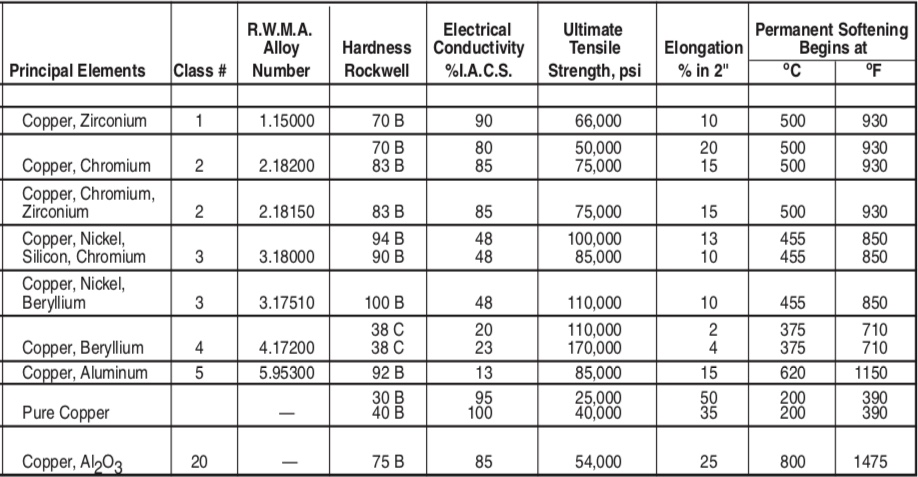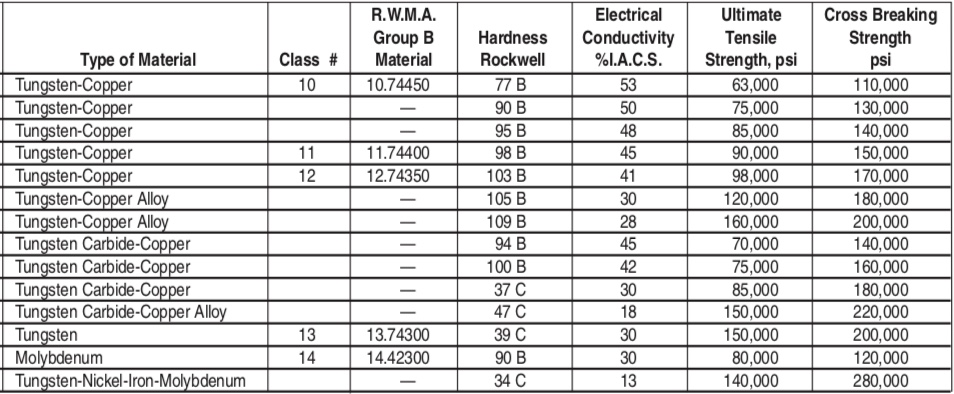Electrode Configurer – Copper Alloy
Electrode Configurer – Copper Alloy
Selecting a Copper Alloy can seem overwhelming, but please use this guide to simplify it for most applications.
You may see tables like the ones below. Now just pick an alloy and your all set! (No… keep reading).


The important thing to note, in terms of selecting an electrode, is the “Class #”. These are the RWMA copper classes. (The Resistance Welding Manufacturer’s Association [RWMA] is a division of the American Welding Society [AWS] and helps develop all the standards for the industry).
Here is an abbreviated guide to copper classes.
- Class 2: Far and away the most common alloy, this is recommended for spot and seam welding cold and hot-rolled steels and coated materials. Class 2 copper is always going to be the most readily available electrode alloy, as well as the least expensive.
- Notice in the chart above, there are actually two alloys that qualify as Class 2.
- Class 2, Copper-Chromium is the most universal.
- Class 2, Copper-Chromium-Zirconium is sometimes used in welding galvanized steels, as there is evidence of it outperforming standard Class 2 on galvanized.
- Notice in the chart above, there are actually two alloys that qualify as Class 2.
- Class 1: This alloy is more electrically conductive than Class 2. It is also softer than Class 2, because of it’s higher copper content. It has poor wear resistance but is made for welding coated steels and high conductivity materials (excluding copper and silver). It is used less often, typically costs more, and is less likely to be in stock.
- Class 3: This alloy is recommended for spot and seam welding stainless steel and high temperature heat resisting alloys that require high weld forces. It is higher strength than Class 2, but the conductivity suffers; it is roughly half as electrically conductive as Class 2. Class 3 is more rare than Class 2 or Class 1, so it’s again more expensive and more difficult to get.
- Notice that there are two alloys of Class 3.
- Beryllium Copper: The Beryllium Class 3 slightly outperforms the alloy without Beryllium. However, Beryllium has been deemed a known carcinogen, and the industry is trying to get away from it.
- Beryllium-Free Copper is often used in Class 3, to avoid any heath hazards. You’ll notice a slightly lower Ultimate Tensile Strength on the Beryllium-Free, but it is often thought to be negligible.
- Notice that there are two alloys of Class 3.
- Class 11: You will not find any electrodes made completely of Class 11, but you may find electrodes with a Class 11 face brazed onto a backup electrode. Class 11 is much more wear resistant than Class 2, and is often used in highly repeatable applications like nut and stud welding.
- Note! Class 11 contains Tungsten. This is made from an ore called Wolframite. Wolframite is on the list of “Conflict Materials” in the United States. In the US, the 2010 Dodd–Frank Wall Street Reform and Consumer Protection Act required publicly held companies to audit their supply chains and report use of conflict minerals. Dodd-Frank enforcement appears to change with the political climate, so you should check with your suppliers and lawyers if you’re publicly held and want to use Tungsten-based alloys.
So, will all that said, probably start your project with Class 2 and go from there.
Now that you know your Copper Alloy, let’s pick a part number!
Back to Electrode Shape Next to Select A Length

